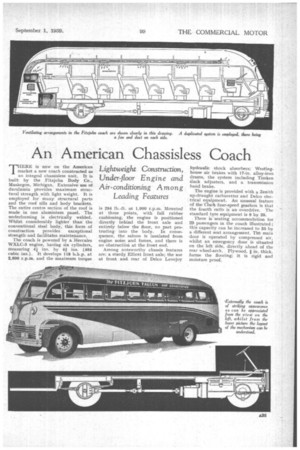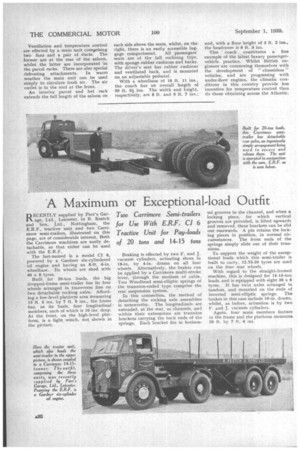An American Chassisless Coach
Page 37

Page 38

If you've noticed an error in this article please click here to report it so we can fix it.
Lightweight Construction, Under-floor Engine and Airconditioning Among Leading Features THERE is now on the American market a new coach constructed as an integral chassisless unit. ft is built by the Fitzjohn BodyCo., Muskegon, Michigan. Extensive rose of duralumin provides maximum structural strength with light weight. It is employed for many structural parts and the roof sills and body brackets. The entire centre section of the roof is made in one aluminium panel. The underframing is electrically welded. Whilst considerably lighter than the conventional steel body, this farm of construction provides exceptional strength and facilitates maintenance.
The coach is powered by a Hercules WXLC-3 engine, having six cylinders, measuring 4i ins. by 91 ins. (409 cubic ins.). It develops 118 b.h.p. at 2,800 r.p.m. and the maximum torque is 299 lb.-ft. at 1,000 r.p.m. Mounted at three points, with full rubber cushioning, the engine is positioned directly behind the front axle and entirely below the floor, no part protruding into the body. In consequence, the saloon is instflated from engine noise and fumes, and there is no obstruction at the front end.
Among noteworthy chassis features are: a sturdy Elliott front axle; the use at front and rear of Delco Lovejoy hydraulic shock absorbers; Westinghouse air brakes with 17-in. alloy-iron drums, the system including Timken slack 'adjusters, and a transmission hand brake.
The engine is provided with a Zenith up-draught carburetter and Delco elec. trical equipment. An unusual feature of the Clark four-speed gearbox is that the fourth ratio is an overdrive. The standard tyre equipment is 9 by 20.
There is seatingaccommodation for 29 passengers in the coach illustrated ; this capacity can be increased to 35 by a different seat arrangement. T132 main door is operated by compressed air, whilst an emergency door is situated on the left side, directly ahead of the rear wheel-arch. Plywood, in, thick, forms the flooring; it is rigid and moisture proof.
Ventilation and temperature control are effected by a main unit comprising two fans and a pair of ducts. The former are at the rear of the saloon, whilst the latter are incorporated in the parcel racks. There are also special defrosting attachments. In warm weather the main unit can be used simply to circulate • fresh air. The air outlet is in the roof at the front.
An interior parcel and hat rack extends the full length of the saloon on each side above the seats, whilst, on the right, there is an easily accessible lug gage compartment. All passengers' seats are of the full reclining type, with sponge rubber cushions and backs. The driver's seat has rubber cushions and ventilated back, and is mounted on an adjustable pedestal.
With a wheelbase of 18 ft. 11 ins., the coach has an overall length of 30 ft. 9i ins. The width and height, respectively, are 8 ft. and 9 ft. 7 ins.;
and, with a floor height of 3 ft. 2 ins., the headroom is 6 ft. 3 ins.
This coach constitutes a fine example of the latest luxury passengervehicle practice. Whilst British engineers are concerning themselves with the development of " chassisless vehicles, and are progressing with under-floor engines, the climatic conditions in this country provide less incentive for temperature control than do those obtaining across the Atlantic.




































































